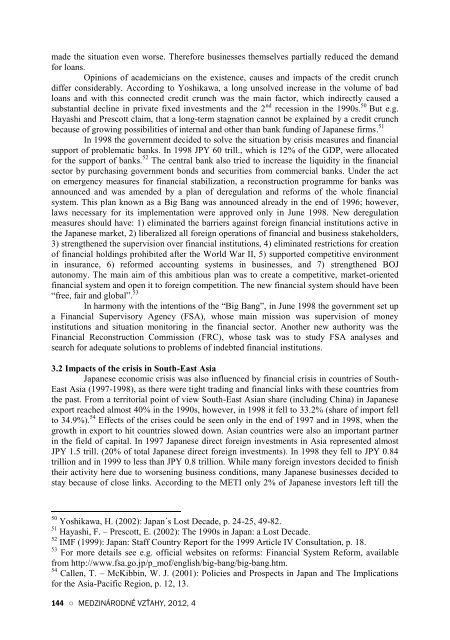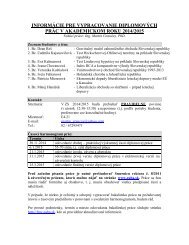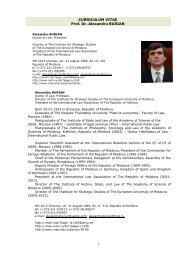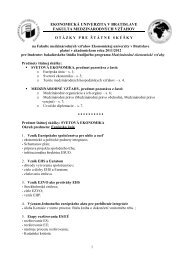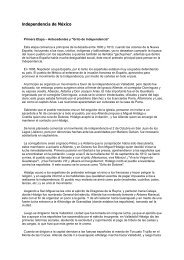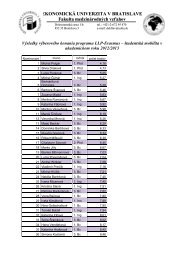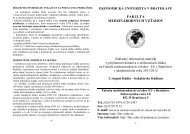preferences. Massive fiscal incetives, stimulus packages and government interventions onlyworsen functioning of the market further. 43On the contrary, Yoshikawa states that the fiscal policy in the 1990s promotedeconomic growth and successfully avoided even bigger slumps in the economy. In 1992-1994the economy would have experienced a zero or negative growth if there hadn´t been increasedgovernment expenditures. 44The crisis of the financial system with its peak in 1997 played an important role in theunfavourable development of the economy. The volume of bad loans of all Japanese banksalmost doubled compared with 1996, to JPY 13.3 trill. In 1998 bad loans represented 5.4% ofall loans and this share was still growing (up to 8.0% in 2002). Credit banks and banks offeringlong-term loans had the biggest volume of NPLs, about 8-10% of all loans. In case of municipaland regional banks this share fluctuated around 4-6% before 2000. 45 Due to worseningeconomic results, banks started to go bankrupt in large numbers. After the collapse of mortgagecompanies and credit co-operatives in previous years, now it was the turn of big banks andother financial institutions. In the end of 1997 e.g. two big companies trading in securities,Sanyo Securities and Yamaichi Securities and Hokkaido Takushoku Bank (in 1996 the 10 thbiggest municipal bank in the country) went bankrupt. 46 Banking houses had to face a fastdecline in the price of securities (index Nikkei 225 fell to the level lower than after bubbledissolution – see figure 1) and outflow of deposits and worries about an overall crisis of thefinancial system grew.Consequences of problems in the financial sector were far reaching. According to theIMF: “a long-term stagnation of the economy weakened the financial sector and the crisis of thefinancial sector in the late 1990s retrospectively had a negative impact on the real economicactivity and restricted the efficiency of economic policy.“ 47 This worsened the mediating role ofbanks and led to the decrease in the efficiency of resource allocation in the economy. In 1997Japan experienced a so-called credit crunch, i.e. the situation when undercapitalized banks areneither able nor willing to offer a sufficient amount of new loans to companies. 48 In the effort tomaintain their capital-adequacy ratio 49 banks started to reduce the amount of newly offeredloans. This was a big problem for the business sector, particularly SMEs which were dependenton these loans.The central bank cannot solve a credit crunch by increasing the money supply, sincethis increase would lead only to the increase in bank reserves. Theoretically ideal, however, afinancially and time very demanding solution, is revival of the financial sector. But both theBOJ and the government were reluctant about this for a long time. The fact that manybusinesses suffered from the decline in the value of their own assets and worsening of their ownbalance, which meant that they had to economize and accept restructuralization programmes,43 Powell, B. (2002): Explaining Japan´s Recession, p. 41.44 Yoshikawa, H. (2002): Japan´s Lost Decade, p. 17.45 IMF (2003) Japan: Financial System Stability Assessment, p. 10.46 Crisis in more details, see e.g. Nakaso, H. (2001): The financial crisis in Japan during the1990s: how the Bank of Japan responded and the lessons learnt.47 IMF (2003): Japan: Financial System Stability Assessment, p. 12-13.48 In the situatuion of a credit crunch the interest doesn´t clear the credit market, demand forloans exceeds their supply.49 BIS defines the capital-adequacy ratio as a ratio between the level of own capital and riskassets. Internationally active banks must maintain the indicator at a minimum level of 8% foroperations in foreign markets and 4% for activities in the domestic market. If the indicator falls,banks must reduce the volume of their loans. For more details see the websites of the BasleCommittee on Banking Supervision www.bis.org/bcbs/index.htm.MEDZINÁRODNÉ VZŤAHY, 2012, 4 ○ 143
made the situation even worse. Therefore businesses themselves partially reduced the demandfor loans.Opinions of academicians on the existence, causes and impacts of the credit crunchdiffer considerably. According to Yoshikawa, a long unsolved increase in the volume of badloans and with this connected credit crunch was the main factor, which indirectly caused asubstantial decline in private fixed investments and the 2 nd recession in the 1990s. 50 But e.g.Hayashi and Prescott claim, that a long-term stagnation cannot be explained by a credit crunchbecause of growing possibilities of internal and other than bank funding of Japanese firms. 51In 1998 the government decided to solve the situation by crisis measures and financialsupport of problematic banks. In 1998 JPY 60 trill., which is 12% of the GDP, were allocatedfor the support of banks. 52 The central bank also tried to increase the liquidity in the financialsector by purchasing government bonds and securities from commercial banks. Under the acton emergency measures for financial stabilization, a reconstruction programme for banks wasannounced and was amended by a plan of deregulation and reforms of the whole financialsystem. This plan known as a Big Bang was announced already in the end of 1996; however,laws necessary for its implementation were approved only in June 1998. New deregulationmeasures should have: 1) eliminated the barriers against foreign financial institutions active inthe Japanese market, 2) liberalized all foreign operations of financial and business stakeholders,3) strengthened the supervision over financial institutions, 4) eliminated restrictions for creationof financial holdings prohibited after the World War II, 5) supported competitive environmentin insurance, 6) reformed accounting systems in businesses, and 7) strengthened BOJautonomy. The main aim of this ambitious plan was to create a competitive, market-orientedfinancial system and open it to foreign competition. The new financial system should have been“free, fair and global”. 53In harmony with the intentions of the “Big Bang”, in June 1998 the government set upa Financial Supervisory Agency (FSA), whose main mission was supervision of moneyinstitutions and situation monitoring in the financial sector. Another new authority was theFinancial Reconstruction Commission (FRC), whose task was to study FSA analyses andsearch for adequate solutions to problems of indebted financial institutions.3.2 Impacts of the crisis in South-East AsiaJapanese economic crisis was also influenced by financial crisis in countries of South-East Asia (1997-1998), as there were tight trading and financial links with these countries fromthe past. From a territorial point of view South-East Asian share (including China) in Japaneseexport reached almost 40% in the 1990s, however, in 1998 it fell to 33.2% (share of import fellto 34.9%). 54 Effects of the crises could be seen only in the end of 1997 and in 1998, when thegrowth in export to hit countries slowed down. Asian countries were also an important partnerin the field of capital. In 1997 Japanese direct foreign investments in Asia represented almostJPY 1.5 trill. (20% of total Japanese direct foreign investments). In 1998 they fell to JPY 0.84trillion and in 1999 to less than JPY 0.8 trillion. While many foreign investors decided to finishtheir activity here due to worsening business conditions, many Japanese businesses decided tostay because of close links. According to the METI only 2% of Japanese investors left till the50 Yoshikawa, H. (2002): Japan´s Lost Decade, p. 24-25, 49-82.51 Hayashi, F. – Prescott, E. (2002): The 1990s in Japan: a Lost Decade.52 IMF (1999): Japan: Staff Country Report for the 1999 Article IV Consultation, p. 18.53 For more details see e.g. official websites on reforms: Financial System Reform, availablefrom http://www.fsa.go.jp/p_mof/english/big-bang/big-bang.htm.54 Callen, T. – McKibbin, W. J. (2001): Policies and Prospects in Japan and The Implicationsfor the Asia-Pacific Region, p. 12, 13.144 ○ MEDZINÁRODNÉ VZŤAHY, 2012, 4
- Page 2 and 3:
Medzinárodné vzťahyVedecký čas
- Page 4 and 5:
ObsahPôvodné vedecké článkyZEN
- Page 6 and 7:
ContentOriginal scientific papersZE
- Page 8 and 9:
P Ô V O D N Ý V E D E C K Ý Č L
- Page 10 and 11:
epublikou a Indickou republikou? Za
- Page 12 and 13:
spočiatku javí iba ako malá sekt
- Page 14 and 15:
Z kulturologického hľadiska tento
- Page 16 and 17:
6. LEHMANNOVÁ, Z. a kol.(2010): Pa
- Page 18 and 19:
krajiny 2 . Zatiaľ čo pri cle pla
- Page 20 and 21:
Textilv ekonomike (P SA /P TA ). 7
- Page 22 and 23:
TextilGraf 3: Účinky subvencií n
- Page 24 and 25:
TextilGraf 4: Účinky subvencií n
- Page 26 and 27:
TextilAnalyzujme teraz rozdiely v d
- Page 28 and 29:
P Ô V O D N Ý V E D E C K Ý Č L
- Page 30 and 31:
dohody, ktorú členský štát uza
- Page 32 and 33:
Na základe návrhu Európskej komi
- Page 34 and 35:
do svojej výlučnej kompetencie, n
- Page 36 and 37:
6. Stanovisko Generálneho advokát
- Page 38 and 39:
a jadrovým programom. Takmer úpln
- Page 40 and 41:
Južná Kórea sa ďalej rozvíjala
- Page 42 and 43:
Napätie medzi obomi štátmi na K
- Page 44 and 45:
Graf 2: Štruktúra tvorby HDP KĽD
- Page 46 and 47:
a luxusného tovaru. Rada bezpečno
- Page 48 and 49:
Osobitnú skupinu ŠEZ tvoria zóny
- Page 50 and 51:
systému na potraviny a iný priemy
- Page 52 and 53:
7. SINGH, L. 2012. India and North
- Page 54 and 55:
D I S K U S I AVÝVOJ MULTILATERÁL
- Page 56 and 57:
chybět příslušné pravomoce k u
- Page 58 and 59:
socialistickou federativní sověts
- Page 60 and 61:
uzavírat bilaterální dohody mezi
- Page 62 and 63:
2 Stěžejní multilaterální obch
- Page 64 and 65:
Pod záštitou UNCTAD byl během ro
- Page 66 and 67:
Celní úmluva ATA karnet pro doča
- Page 68 and 69:
těchto práv jednotlivými státy
- Page 70 and 71:
zejména na nastolování obchodu v
- Page 72 and 73:
33. ORGANISATION FOR ECONOMIC CO-OP
- Page 74 and 75:
D I S K U S I AFAKTORY ROZVOJA A RA
- Page 76 and 77:
tradície a pomerne ľahko sa dost
- Page 78 and 79:
1979 ajatollách Chomejní povolil
- Page 80 and 81:
moslimských krajín - vytvárať n
- Page 82 and 83:
nachádzali v Pakistane, kde v úlo
- Page 84 and 85:
jedna skupina argumentuje množstvo
- Page 86 and 87:
28. OLCOTT, M. BRILL (2012). Centra
- Page 88 and 89:
planéty Zem, je možné identifiko
- Page 90 and 91:
vysokohorských ľadovcov a snehove
- Page 92 and 93:
populácie človeka. Len v roku 200
- Page 94 and 95: s tým sú „tiché“ krízy spô
- Page 96 and 97: druhov rastlín alebo globálne ote
- Page 98 and 99: 10. MACGRANAHAN, G., BALK, D. , et
- Page 100 and 101: D I S K U S I ASÚČASNÉ A OČAKÁ
- Page 102 and 103: v Afrike, keďže Maurícius nedisp
- Page 104 and 105: v Baoaré. Krajina patrí medzi naj
- Page 106 and 107: nadmerné znečistenie vody v Čín
- Page 108 and 109: ZÁVERPredkladaný článok analyzu
- Page 110 and 111: D I S K U S I AŠPECIFIKÁ POSTAVEN
- Page 112 and 113: stálym obyvateľstvom, definovaný
- Page 114 and 115: občianstve, ktoré zakladajú prim
- Page 116 and 117: Špecifické a nezameniteľné post
- Page 118 and 119: dochádza v prípadoch exilových v
- Page 120 and 121: P R E H Ľ A DPROBLEM OF EASTERN PA
- Page 122 and 123: countries where the development of
- Page 124 and 125: In the Joint Declaration it was sta
- Page 126 and 127: On the partners’ side we see that
- Page 128 and 129: espect for ordinary citizens of the
- Page 130 and 131: P R E H Ľ A DJAPAN´S LOST DECADE:
- Page 132 and 133: often called a “bubble boom” or
- Page 134 and 135: investments into properties - see t
- Page 136 and 137: Ongoing appreciation of the currenc
- Page 138 and 139: usinesses etc.) as well as by long-
- Page 140 and 141: eject it), but he favours the monet
- Page 142 and 143: was bound to take steps. Many other
- Page 146 and 147: end of 1998. 55 The crisis also dee
- Page 148 and 149: The central bank also responded to
- Page 150 and 151: 4. CALLEN, T. - McKIBBIN, W. J. (20
- Page 152 and 153: 1, February 2001. [20.3.2008.] Avai
- Page 154 and 155: P R E H Ľ A DINŠTITUCIONÁLNE MOD
- Page 156 and 157: zahraničného obchodu s Nemeckom (
- Page 158 and 159: diplomacie v podmienkach, keď real
- Page 160 and 161: organizačnej matice sú: ministers
- Page 162 and 163: neprítomnosti ďalších pilierov
- Page 164 and 165: oddelenia, sú v rámci veľvyslane
- Page 166 and 167: ktorý aplikuje Nemecko. V tomto mo
- Page 168 and 169: ZÁVERModely organizácie hospodár
- Page 170 and 171: 20. TÓTH, Ľ. - HORVÁTHOVÁ, K. (
- Page 172 and 173: podmienky. Od sedemdesiatych rokov
- Page 174 and 175: 1 Tradičné teórie medzinárodný
- Page 176 and 177: okolitých štátov. Násilné pres
- Page 178 and 179: 1.3 NeorealizmusRealistický smer s
- Page 180 and 181: a morálnosti. Teroristické a extr
- Page 182 and 183: 17. NYE, Joseph S. (2004): The Bene
- Page 184 and 185: právnom rámci, ktorý poskytne od
- Page 186 and 187: Tretím a posledným princípom je
- Page 188 and 189: III.IV.s adekvátnou ochranou vodn
- Page 190 and 191: Podľa princípu spravodlivého a r
- Page 192 and 193: POUŽITÁ LITERATÚRA:1. BENCALA, K
- Page 194 and 195:
1 Funkcia ropného trhuPodľa zákl
- Page 196 and 197:
neštandardné pohyby cien v roku 2
- Page 198 and 199:
forwardových obchodov, kde je kaž
- Page 200 and 201:
Idea konceptu racionálnej špekul
- Page 202 and 203:
5. GRANČAY, M.: Hypotekárny trh U
- Page 204 and 205:
chrobáky a červy považujú za v
- Page 206:
INŠTRUKCIE PRE AUTOROVPríspevky d


